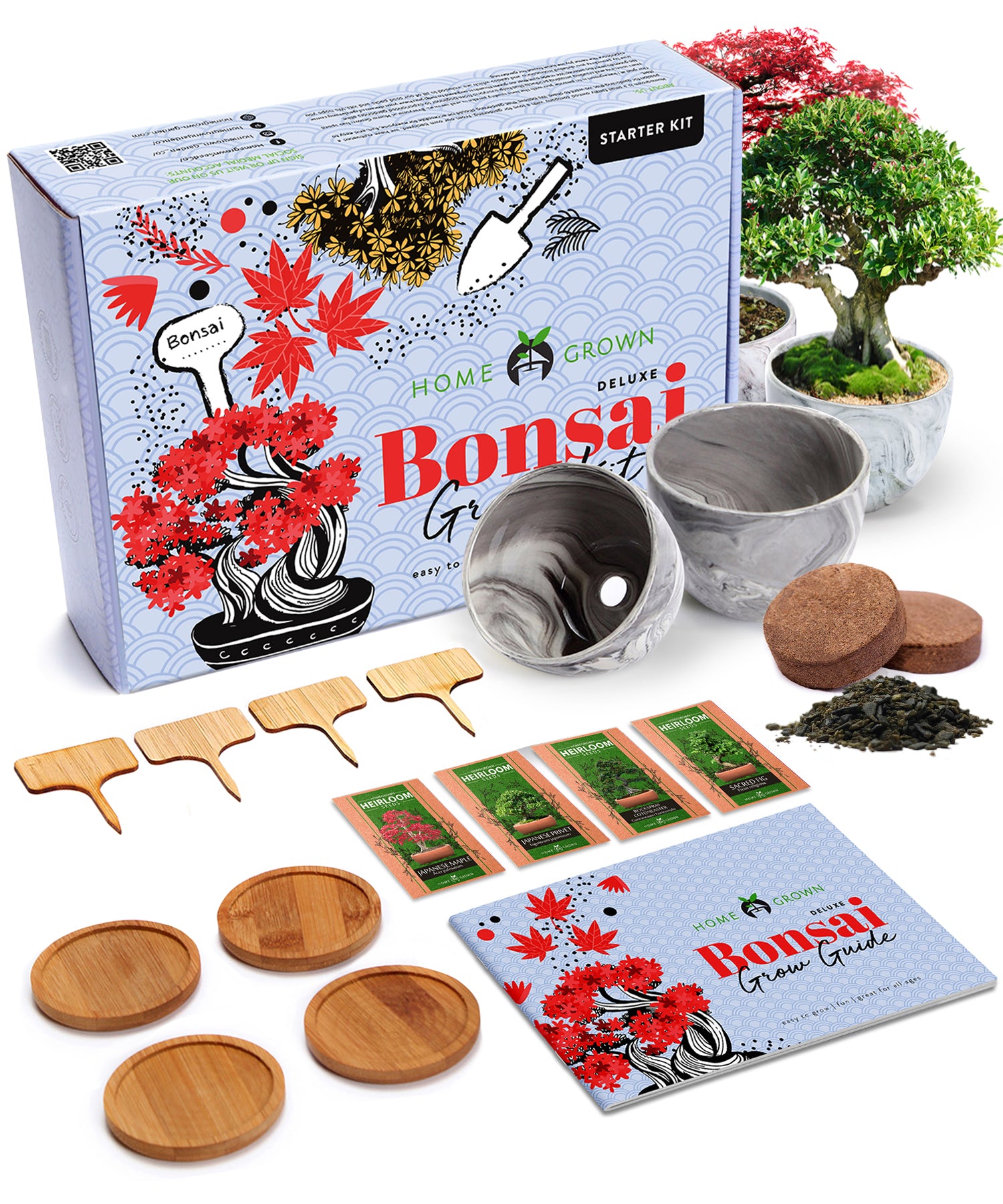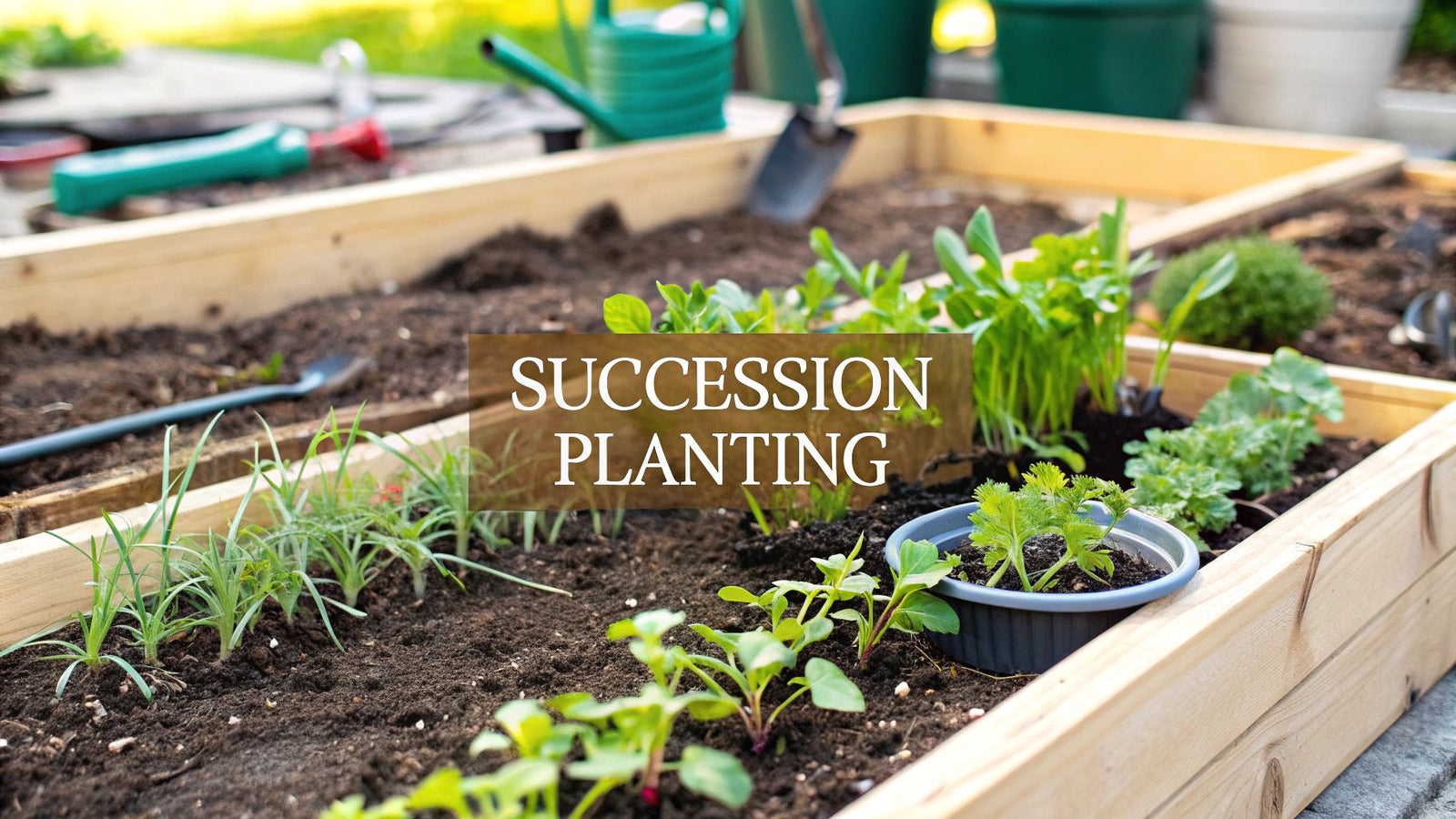
Succession planting is one of the smartest strategies you can add to your gardening toolkit. At its core, it's a simple idea: instead of planting everything at once, you sow crops in waves. This staggered approach avoids the classic "feast or famine" problem where you're either drowning in produce or have nothing at all.
This method keeps your garden productive and your kitchen stocked with a steady stream of fresh vegetables all season long. It's a game-changer.
What Is Succession Planting Really
We’ve all been there. You plant everything in May, and come July, you're buried under a mountain of zucchini for three weeks straight. Then, just as suddenly, your garden is empty for the rest of the season. Succession planting offers a much better rhythm.
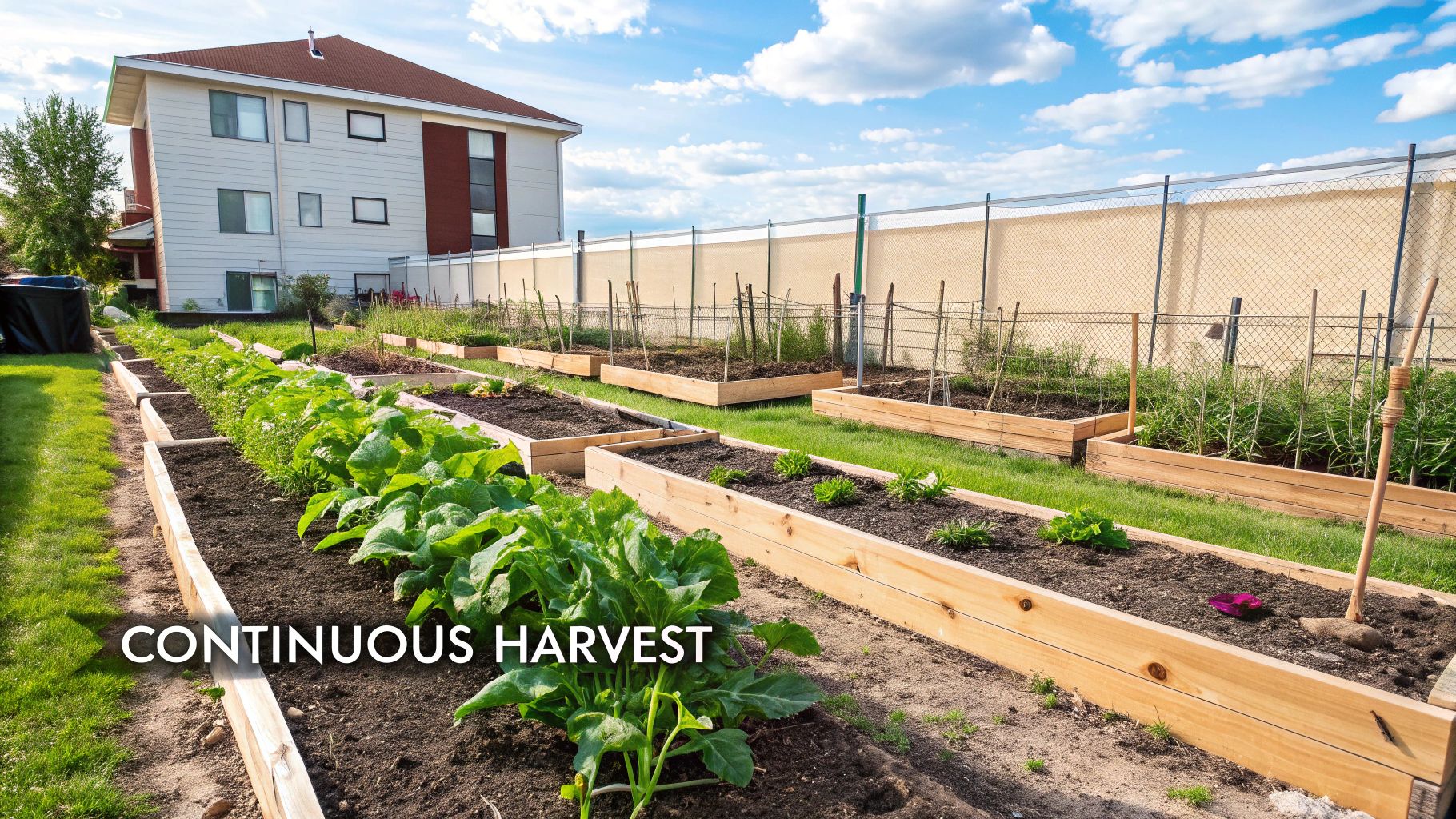
Think of it like a baker. Does she bake an entire month's worth of bread on the first day? Of course not. She bakes a fresh batch every morning to ensure a steady supply. By planting a small row of lettuce every two weeks, you can do the same, giving you crisp salads for months instead of harvesting 30 heads all at once.
The Core Idea of Continuous Harvests
The whole point is to stretch your harvest season out by being strategic with your timing and spacing. Instead of treating your garden like a one-and-done project, you start seeing it as a dynamic, constantly producing space.
Succession planting transforms your garden from a short sprint into a season-long marathon. It maximizes your yield per square foot by ensuring no space sits empty and unproductive for long.
This isn't some complex agricultural science; it's a totally accessible technique for any home gardener. As soon as one crop comes out, another goes in. To really get the hang of it, it helps to understand the wider principles of achieving overall vegetable gardening success.
To quickly break it down, here's a look at the key concepts behind succession planting.
Succession Planting At a Glance
This table offers a snapshot of what succession planting is all about, from the main idea to the results you can expect in your garden.
| Concept | Goal | Best For | Primary Benefit |
|---|---|---|---|
| Staggering Plantings | Sow the same crop at regular intervals (every 2-3 weeks). | Fast-growing crops like lettuce, radishes, and bush beans. | Prevents a single, overwhelming harvest. |
| Replacing Harvested Crops | Immediately plant a new crop where an old one was removed. | Any garden space, especially small plots and raised beds. | Maximizes the use of every square foot. |
| Using Different Varieties | Plant varieties of the same vegetable with different maturity dates. | Crops like tomatoes, corn, and cabbage. | Extends the harvest window without replanting. |
Ultimately, these techniques all work together to turn your garden into a reliable source of fresh food from early spring right through to the first frost.
The 5 Big Wins of a Continuous Harvest Garden
When you get into the rhythm of succession planting, you fundamentally change your garden's pace. Gone are the days of a single, frantic harvest that leaves you with a mountain of zucchini on the counter. Instead, you get to enjoy a garden that's more rewarding, more productive, and frankly, a lot less stressful.
The most immediate payoff is right there in the name: a continuous harvest. Think about it—fresh salad greens for months on end, not just for a couple of weeks in June. By popping in a new row of lettuce seeds every two or three weeks, you create a steady, predictable supply that keeps your kitchen stocked from the last frost of spring to the first one of fall. This simple technique puts a definitive end to the frustrating "feast or famine" cycle that plagues so many gardeners.
Get the Most Out of Your Garden Space
Succession planting is also the secret to making every square inch of your garden work for you all season long. As soon as you pull up that first crop of spring radishes, that spot doesn't just sit empty and wait for weeds to move in. You can immediately pop in something new, like a crop of heat-loving bush beans. This constant rotation keeps your soil active and productive from start to finish.
It’s a mindset shift. You stop thinking about your garden as a single event and start treating it like a highly efficient, food-producing system. You're not just growing one garden; you're essentially growing two or three in the very same plot over a single year.
This strategic replanting can seriously boost your total yield. It's not uncommon for home gardeners who master succession planting to see their productivity jump by 30–50%. Many report harvesting 10–15 different crops from a single bed in one season, a huge leap from the typical four or five. You can dig into more of the data on these impressive harvest improvements over at Garden Therapy.
Cultivate a Healthier Garden Ecosystem
Beyond the bigger harvests, this approach also fosters healthier soil and more resilient plants. It’s a win-win.
Here’s a quick look at how it works:
- Deters Pests and Diseases: When you stagger your plantings, you break up the life cycles of common garden pests that zero in on specific plants. A massive, single planting of broccoli, for example, is basically an all-you-can-eat buffet for cabbage worms. Smaller, successive plantings are a much less attractive target.
- Cuts Down on Food Waste: Having a steady, manageable supply means you harvest what you need, right when you need it. This avoids that heartbreaking moment of finding perfectly good vegetables rotting on the vine or forgotten in the crisper drawer simply because you had too much at once.
- Builds Better Soil: Keeping the ground covered with living plants is fantastic for your soil. It prevents erosion from wind and rain, naturally suppresses weeds, and helps maintain a healthy, crumbly structure. Plus, the constant rotation of different plants adds a variety of organic matter back into the earth, keeping it fertile and full of life.
Step 1: Map Out Your Planting Schedule
Believe it or not, the most important part of succession planting happens long before you get your hands dirty. A little bit of planning is the secret to a garden that keeps on giving, and it all starts with a simple schedule.
Your entire growing season is framed by two critical dates: your area's last spring frost and its first fall frost. These dates are your starting and ending lines. If you don't know yours offhand, a quick online search for your city or gardening zone will give you what you need.
Think of these dates as the bookends for your whole season, helping you visualize when you can plant and for how long.
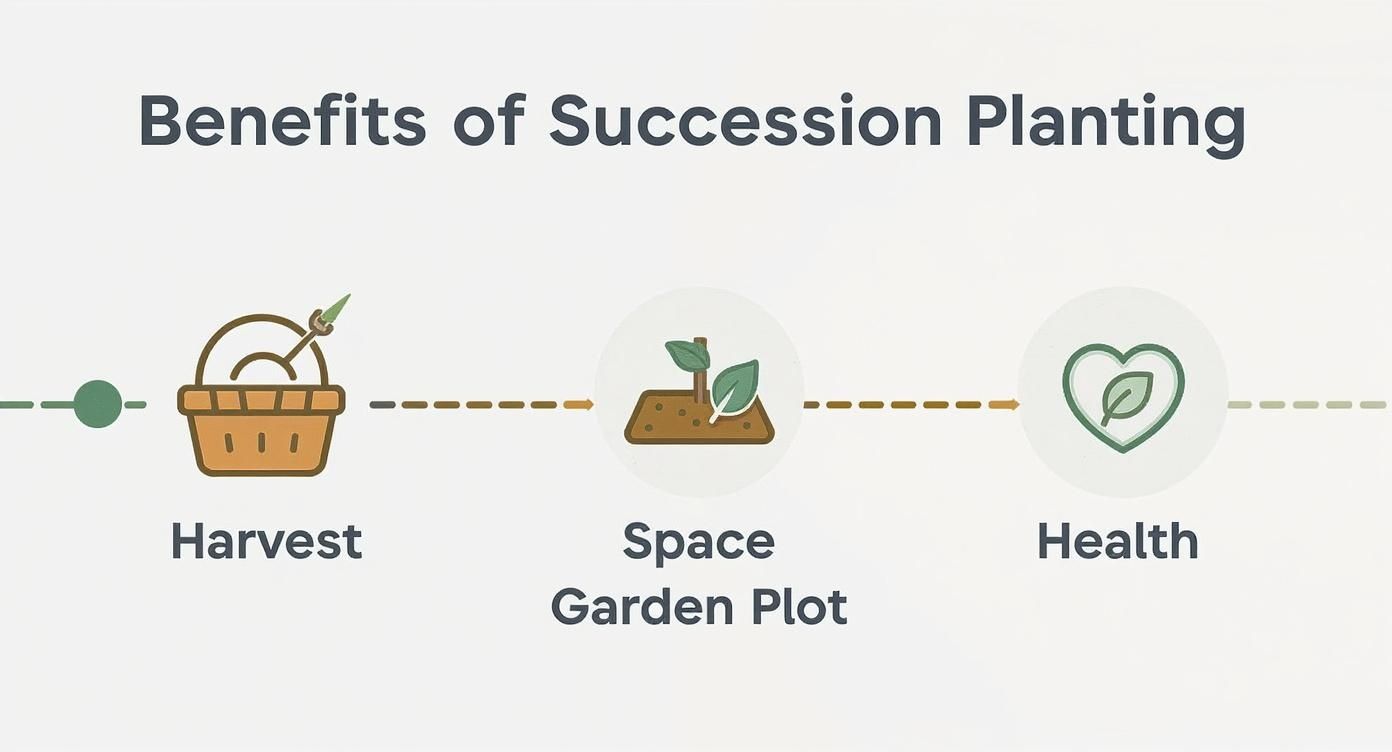
As the infographic shows, the goal is to have the next crop ready to go in as soon as one is finished. This constant rotation keeps your soil active and your kitchen stocked.
Let Your Seed Packets Be Your Guide
Once you know the length of your growing season, grab your seed packets. They hold the next piece of the puzzle: the "days to maturity." This number is an estimate of how long it takes for that specific plant to go from a tiny seed to your first harvest.
So, how does this work in practice? Let's say you have a radish variety that takes about 30 days to mature. If your last frost date is May 15th, you can start planting then and sow a new, small batch every couple of weeks to keep them coming. You can also work backward from your first fall frost to figure out the absolute last day you can plant something and still expect a harvest before winter sets in.
I find that sketching out a simple chart on paper or in a spreadsheet is the best way to keep track of everything. Just make columns for the vegetable, its days to maturity, and the dates you plan to sow the seeds.
This simple map takes all the guesswork out of the process. For a deeper dive into timing, our guide on when to plant vegetable seeds can help you build the perfect calendar for your specific garden.
Step 2: Choose From 11 Best Vegetables for Staggered Planting
Picking the right crops is where a succession planting plan really comes to life. You want to look for vegetables that grow up fast, letting you plant, pick, and then plant again without missing a beat. The sweet spot? Anything that's ready to harvest in 60 days or less.
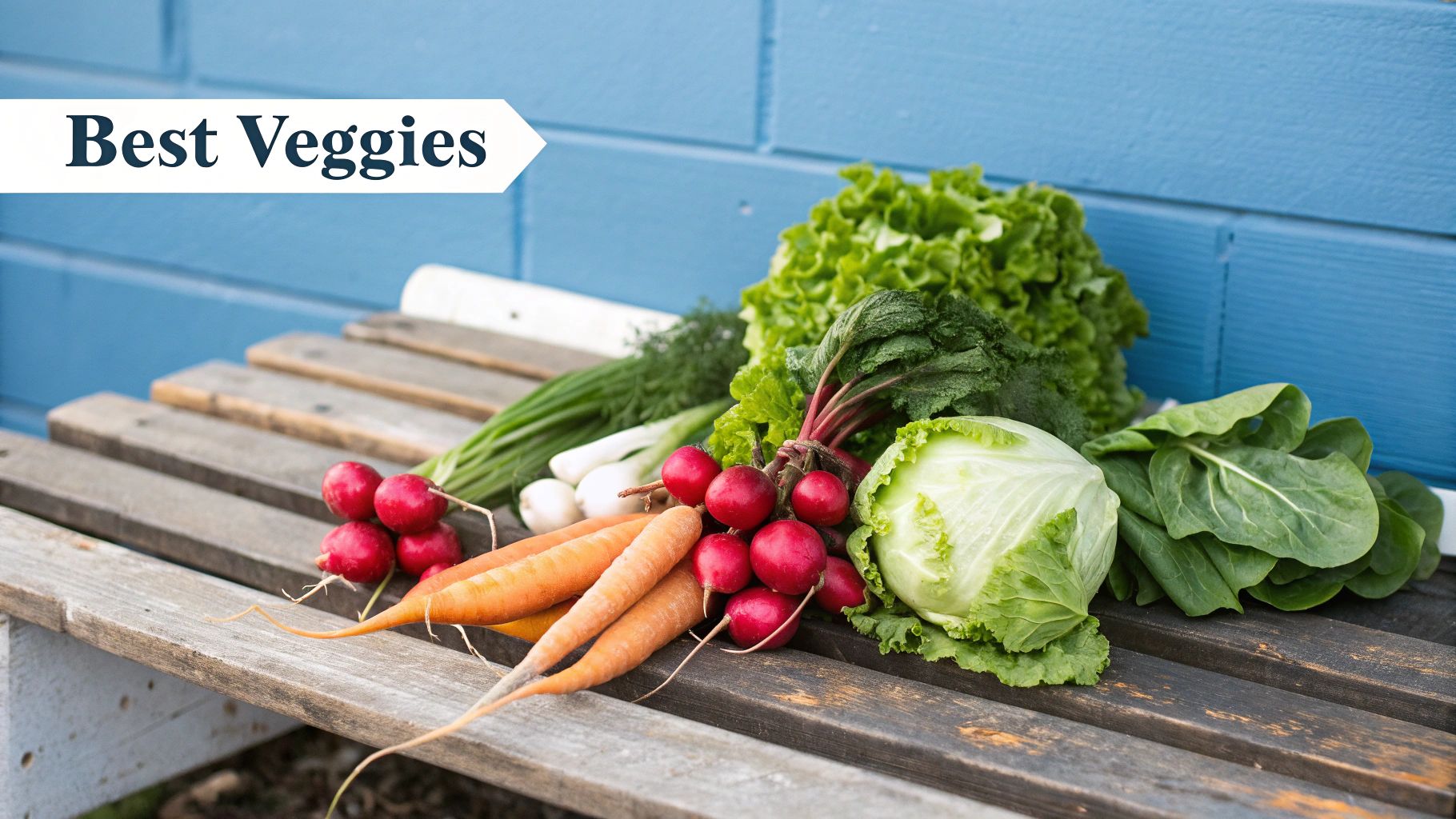
This quick turnaround is your secret weapon for squeezing multiple harvests out of a single season. Imagine sowing a new round of seeds every two or three weeks—that’s how you get a truly continuous supply. It’s not just a theory, either. Studies have shown that staggered plantings of quick crops like radishes and leafy greens can dramatically increase your total harvest. One study found this method yielded 4.2 kg of greens per square meter, a huge jump from the 2.8 kg produced by a single planting.
Top 11 Performers for Continuous Harvests
So, where should you start? Here’s a list of tried-and-true vegetables that gardeners love for succession planting. They’re reliable, grow quickly, and are perfect whether you're a beginner or have years of experience.
- Lettuce: Put in new seeds every 14-21 days. For summer plantings, look for bolt-resistant varieties like 'Black Seed Simpson' that can handle the heat.
- Radishes: These are incredibly fast, often ready in as little as 25 days. Sow a new row every couple of weeks, and you’ll never be without them.
- Spinach: This cool-weather powerhouse is perfect for spring and fall. Plant a new batch every 10-14 days for an endless supply of salad greens.
- Bush Beans: No trellis needed and they mature in a snap. Keep planting new crops every two weeks until about mid-summer.
- Arugula: Peppery, zesty, and fast. You can be harvesting this green in just 3-4 weeks.
- Carrots: Sow a new patch every three weeks. The key here is to keep the soil consistently moist to help the seeds germinate.
- Beets: You get two crops in one—the roots and the delicious greens. Plant a new round every 2-3 weeks.
- Bok Choy: A fantastic leafy green for a quick harvest, often ready to go in around 45 days.
- Cilantro: This herb is notorious for bolting in the heat, so the trick is to plant a small amount every two weeks to keep a fresh supply on hand.
- Green Onions (Scallions): Super easy and fast. Sow more seeds every few weeks, and you’ll have them all season long.
- Kale: While a single plant can last a long time, you can treat it like a cut-and-come-again crop by harvesting the young leaves continuously.
Looking for even more ideas? Many of the crops we recommend for first-time gardeners are also fantastic for succession planting. You can find more inspiration in our guide to the best vegetables to grow for beginners.
Step 3: Master 4 Key Succession Planting Techniques
https://www.youtube.com/embed/T6zdbLza31s
Succession planting isn't a single, rigid rule. Think of it more like a flexible toolkit of smart gardening strategies. Once you have a handle on your basic planting schedule, you can start layering in these different techniques to squeeze even more produce out of your garden space.
These four methods are really the foundation for creating a truly continuous harvest. You can use them on their own or, for even better results, mix and match them. Let's break down how each one works.
1. Staggered Planting
This is the classic approach and probably the easiest one to get started with. Staggered planting simply means you sow a new, small batch of the same crop every couple of weeks.
So, instead of planting all your bush beans at once in May and getting buried in them, you'd plant a small patch every two weeks through mid-summer. This creates a steady, manageable supply for your kitchen—no overwhelming gluts, just fresh beans ready right when you need them.
2. Relay Cropping
Relay cropping is a wonderfully clever technique where you plant new seeds amongst established plants that are nearing their harvest time. It’s like a relay race for your veggies; the next "runner" is already on the track and warming up before the first one even finishes.
A great real-world example is tucking pumpkin or winter squash seeds around the base of your corn stalks a few weeks before the corn is ready. The corn gives the young squash seedlings a bit of shade, and by the time you chop down the corn stalks, the squash is ready to take over that space for the rest of the season. To make this work well, understanding what is direct seeding is a huge help.
3. Intercropping
Also known as interplanting, intercropping is the art of pairing plants that grow at different speeds in the same bed. You get to harvest the fast-growing crop long before the slow-growing one needs all the space. It’s a brilliant way to essentially grow two things in the same footprint.
By pairing plants with different growth rates, intercropping lets you harvest from a garden bed while another crop is still maturing. It’s a brilliant space-saving tactic for small gardens.
Try planting rows of quick-growing radishes or spinach between your tomato or broccoli plants. You’ll be pulling up fresh radishes in about a month, right as the bigger plants are starting to stretch their leaves and demand more elbow room.
4. Multi-Variety Planting
This might just be the simplest method of all. It just means planting a few different varieties of the same vegetable at the same time, choosing ones with different "days to maturity."
For instance, you could plant three types of cabbage on the same day: an early variety that matures in 60 days, a mid-season one that takes 75 days, and a late-season one that needs 90 days. You get all the planting done in one go, but the varieties themselves naturally stagger the harvest for you. It’s a fantastic way to get a long harvest window with very little effort.
Step 4: Keep Your Nonstop Garden Going Strong
Think of your nonstop garden as a living, breathing system. To keep it churning out fresh harvests all season, you've got to give it consistent attention. Good maintenance isn't just a chore; it's what fuels the whole cycle and ensures every new batch of plants has a fighting chance.
The single most important habit to get into? Timely harvesting. The moment a crop is ready, pick it. This doesn't just put the best-tasting food on your table; it frees up precious garden real estate for the next seedling waiting in the wings.
Replenish and Rejuvenate Your Soil
Every time you pull a carrot or snip a head of lettuce, you’re taking nutrients out of the soil. To keep the garden from running on empty, you have to put something back. Amending the soil between plantings is a quick but absolutely critical step.
- Add Compost: Before tucking in the next round of plants, spread a 1- to 2-inch layer of compost and gently work it into the top few inches of soil. This is the fastest way to restore nutrients and keep your soil light and healthy.
- Use Organic Fertilizer: A sprinkle of a balanced, slow-release organic fertilizer gives new transplants the steady food they need to establish themselves quickly.
This simple refresh ensures the next crop has everything it needs to thrive. The power of this rhythm is seen everywhere, even in commercial flower farming. One study found that sowing zinnias every 21 days boosted stem production by a whopping 35% compared to just one big planting. Each new wave delivered a fresh flush of perfect blooms. You can find more great tips on cut flower successions over at Sierra Flower Farm.
Smart Watering and Weed Control
With plants at every stage of life, you can't just turn on a sprinkler and walk away. Young seedlings need consistent moisture near the surface to get their roots established. Mature plants, on the other hand, do better with deep, less frequent watering that encourages their roots to dig down.
And finally, you have to stay on top of the weeds. They’re fierce competitors, stealing water, sunlight, and nutrients from your crops. Your best defense is a thick blanket of mulch—straw or shredded leaves work beautifully. Mulch smothers weeds, holds in moisture, and even helps keep the soil cool on hot days.
Of course, a productive garden can also be a beautiful one. As you're maintaining your beds, you might think about adding permanent structural elements. For some beautiful inspiration on integrating features like stone walls for garden accents, there are plenty of resources that show how to blend function and style.
Step 5: Get Answers to Your Top Succession Planting Questions
As you start mapping out your garden, you're bound to have questions. That's completely normal! Getting a few key concepts straight from the start can make the difference between a garden that thrives and one that sputters out.
Let's dig into some of the most common questions that pop up when gardeners first try this technique.
How Do I Know When to Stop Planting?
This is probably the most critical question of all. The secret here is to work backward from your area's first average frost date.
First, find that date for your specific location. Once you have it, grab your seed packets and look for the "days to maturity." Simply count back that number of days from your frost date, and you've found the last safe day to plant that particular crop.
For example, let's say your first frost usually hits around October 15th. If you're planting carrots that need 70 days to mature, you'll want to get those seeds in the ground by early August at the latest.
A Few More Common Questions
Here are some quick answers to other things that might be on your mind:
- Can I do this in containers? Absolutely! Succession planting is a game-changer for anyone gardening in pots or raised beds. It’s the best way to get the most out of a small space. Just make sure you're using a top-notch potting mix.
- What if I fall behind schedule? Don't sweat it. Think of your schedule as a helpful guide, not a set of strict rules. If you miss a planting window, just get back to it when you can. You might even plant a faster-growing crop to catch up.
- Does this mean I need more fertilizer? You're asking more from your soil, so you need to give more back. But it’s not about just dumping on more fertilizer. The best approach is to add a 1-inch layer of compost between plantings. This keeps your soil teeming with life and nutrients.
At Homegrown Garden, we believe everyone can enjoy a continuous harvest. Explore our premium heirloom seeds and find the perfect varieties to kickstart your succession planting plan today.

